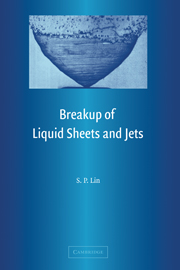Book contents
- Frontmatter
- Contents
- Notation List
- Preface
- 1 Introduction
- 2 Uniform Inviscid Liquid Sheets
- 3 Nonuniform Inviscid Liquid Sheets
- 4 Viscous Liquid Sheet
- 5 Waves on Liquid Sheets
- 6 Phenomena of Jet Breakup
- 7 Inviscid Jets
- 8 A Viscous Jet
- 9 Roles Played by Interfacial Shear
- 10 Annular Liquid Jets
- 11 Nonlinear Capillary Instability of Liquid Jets and Sheets
- 12 Epilogue
- Appendixes
- Author Index
- Subject Index
6 - Phenomena of Jet Breakup
Published online by Cambridge University Press: 02 December 2009
- Frontmatter
- Contents
- Notation List
- Preface
- 1 Introduction
- 2 Uniform Inviscid Liquid Sheets
- 3 Nonuniform Inviscid Liquid Sheets
- 4 Viscous Liquid Sheet
- 5 Waves on Liquid Sheets
- 6 Phenomena of Jet Breakup
- 7 Inviscid Jets
- 8 A Viscous Jet
- 9 Roles Played by Interfacial Shear
- 10 Annular Liquid Jets
- 11 Nonlinear Capillary Instability of Liquid Jets and Sheets
- 12 Epilogue
- Appendixes
- Author Index
- Subject Index
Summary
A liquid jet emanating from a nozzle or orifice exhibits richly varied phenomena that depend on the orifice geometry, the inlet condition before the jet is emanated, and the environmental situation into which the jet is issued. A liquid jet cannot escape the ultimate fate of breakup because of hydro-dynamic instability. The breakup possesses two major regimes: large drop formation and fine spray formation. These two regimes are controlled by distinctively different physical forces, and between them there exist intermediate regimes. All the regimes arise from a subtle dynamic response of the jet to the disturbances.
Geometry of Liquid Jets
Citing the experiment of Bidone, Rayleigh (1945, p. 355) stated, “Thus in the case of an elliptical aperture, with major axis horizontal, the sections of the jet taken at increasing distances gradually lose their ellipticity until at a certain distance the section is circular. Further out the section again assumes ellipticity, but now with major axis vertical.” This statement is illustrated in Figure 6.1, which was taken from Taylor (1960), who also carried out the experiment. The phenomenon was understood as the vibration of a jet enclosed in an envelope of constant tension about its equilibrium configuration with a circular cross section. However, Taylor (1960) demonstrated that the phenomenon can still be predicted without the surface tension in the absence of gravity. With gravity, if the jet is issued vertically downward, it will accelerate.
- Type
- Chapter
- Information
- Breakup of Liquid Sheets and Jets , pp. 102 - 107Publisher: Cambridge University PressPrint publication year: 2003



